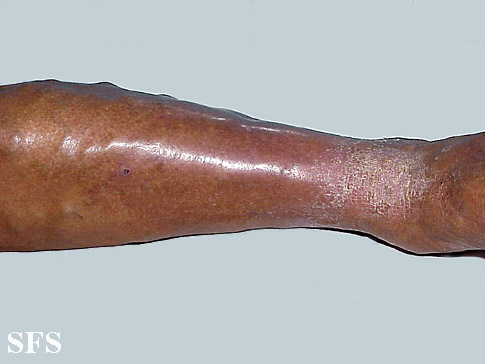Stasis dermatitis
|
WikiDoc Resources for Stasis dermatitis |
|
Articles |
|---|
|
Most recent articles on Stasis dermatitis Most cited articles on Stasis dermatitis |
|
Media |
|
Powerpoint slides on Stasis dermatitis |
|
Evidence Based Medicine |
|
Cochrane Collaboration on Stasis dermatitis |
|
Clinical Trials |
|
Ongoing Trials on Stasis dermatitis at Clinical Trials.gov Trial results on Stasis dermatitis Clinical Trials on Stasis dermatitis at Google
|
|
Guidelines / Policies / Govt |
|
US National Guidelines Clearinghouse on Stasis dermatitis NICE Guidance on Stasis dermatitis
|
|
Books |
|
News |
|
Commentary |
|
Definitions |
|
Patient Resources / Community |
|
Patient resources on Stasis dermatitis Discussion groups on Stasis dermatitis Patient Handouts on Stasis dermatitis Directions to Hospitals Treating Stasis dermatitis Risk calculators and risk factors for Stasis dermatitis
|
|
Healthcare Provider Resources |
|
Causes & Risk Factors for Stasis dermatitis |
|
Continuing Medical Education (CME) |
|
International |
|
|
|
Business |
|
Experimental / Informatics |
Editor-In-Chief: C. Michael Gibson, M.S., M.D. [1]; Associate Editor(s)-in-Chief: Jesus Rosario Hernandez, M.D. [2].
Synonyms and keywords: Congestion eczema, gravitational dermatitis, gravitational eczema, stasis eczema, varicose eczema.
Overview
Stasis dermatitis (also known as "Congestion eczema," "Gravitational dermatitis," "Gravitational eczema," "Stasis eczema," and "Varicose eczema")[1] refers to the skin changes that occur in the leg as a result of "stasis" or blood pooling from insufficient venous return; the alternative name of varicose eczema comes from a common cause of this being varicose veins.[citation needed]
Insufficient venous return results in increased pressure in the capillaries with the result that both fluid and cells may "leak" out of the capillaries. This results in red cells breaking down, with iron containing hemosiderin possibly contributing to the pathology of this entity.[2]
Symptoms
- The skin appears thin, brown and tissue-like, with possible skin lesions (macule or patches), red spots, superficial skin irritation and/or darkening and/or thickening of the skin at the ankles or legs
- The skin may be weakened and may ulcerate in areas
- Legs, ankles, or other areas may become swollen
- Open sores, ulcers
- Itching and/or leg pains
- Sometimes pain may persist from swollen tissues and may feel like "stabbing" or "needle pricks"
The cracks and poor skin-condition of this disorder predisposes for the entry of bacterial infection causing spreading cellulitis infection in the leg. If the skin condition deteriorates further and breaks down, a venous ulcer (also known as a stasis ulcer) may form.
Gallery
Skin
Extremities
Treatment
Treatment may consist of topical applications of steroid based creams and the use of compression stockings to help force the underlying buildup of fluids back out of the lower leg or intermittent pneumatic compression pumps.[medical citation needed]
References
- ↑ Rapini, Ronald P.; Bolognia, Jean L.; Jorizzo, Joseph L. (2007). Dermatology: 2-Volume Set. St. Louis: Mosby. pp. Chapter 14. ISBN 1-4160-2999-0.
- ↑ "Stasis dermatitis and ulcers". United States National Institute of Health. Retrieved July 31, 2008.

